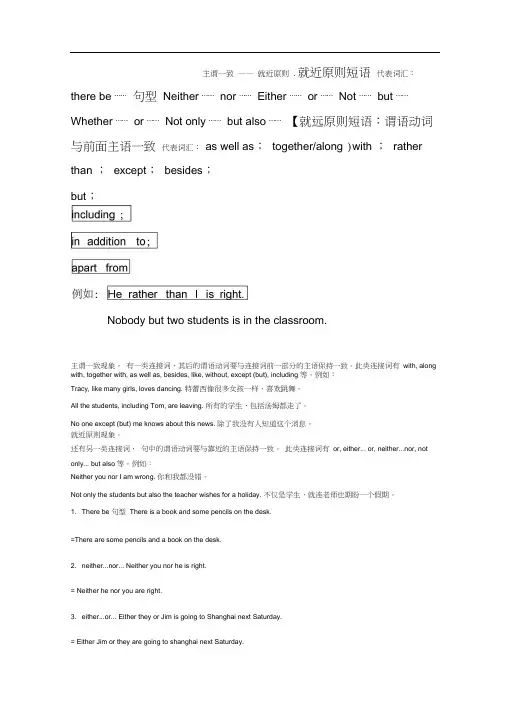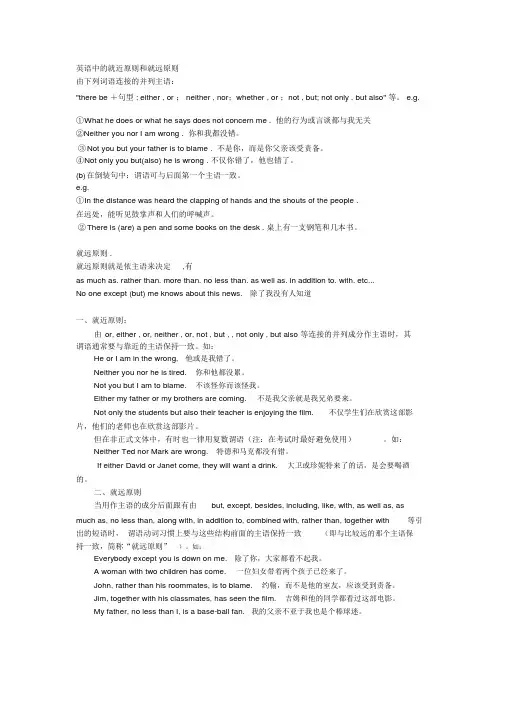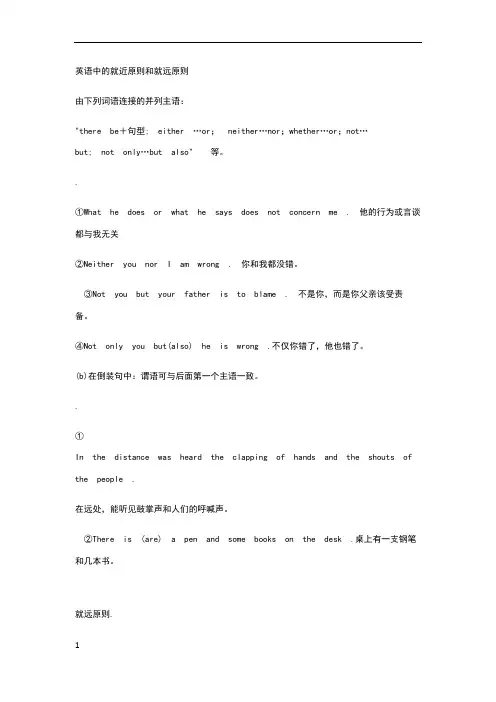英语中的就近原则和就远原则ppt课件.ppt
- 格式:ppt
- 大小:1.10 MB
- 文档页数:5



主谓一致——就近原则. 就近原则短语代表词汇:there be ⋯⋯句型Neither ⋯⋯nor ⋯⋯Either ⋯⋯or ⋯⋯Not ⋯⋯but ⋯⋯Whether ⋯⋯or ⋯⋯Not only ⋯⋯but also ⋯⋯【就远原则短语:谓语动词与前面主语一致代表词汇:as well as;together/along )with ;rather than ;except;besides;but;Nobody but two students is in the classroom.主谓一致现象。
有一类连接词,其后的谓语动词要与连接词前一部分的主语保持一致。
此类连接词有with, along with, together with, as well as, besides, like, without, except (but), including 等。
例如:Tracy, like many girls, loves dancing. 特蕾西像很多女孩一样,喜欢跳舞。
All the students, including Tom, are leaving. 所有的学生,包括汤姆都走了。
No one except (but) me knows about this news. 除了我没有人知道这个消息。
就近原则现象。
还有另一类连接词,句中的谓语动词要与靠近的主语保持一致。
此类连接词有or, either... or, neither...nor, not only... but also 等。
例如:Neither you nor I am wrong. 你和我都没错。
Not only the students but also the teacher wishes for a holiday. 不仅是学生,就连老师也期盼一个假期。
1. There be 句型There is a book and some pencils on the desk.=There are some pencils and a book on the desk.2. neither...nor... Neither you nor he is right.= Neither he nor you are right.3. either...or... Either they or Jim is going to Shanghai next Saturday.= Either Jim or they are going to shanghai next Saturday.4. not only...but also... Not only Ann but also her parents stay at home every Sunday.= Not only Ann's parents but also she stays at home every Sunday.百度词条:就近原则也称“邻近原则”就“近一致原则”(Proximity),即:谓语与靠近的名词、代词(有时不一定是主语)在“人称、数”上一致。




英语中的就近原则和就远原则由下列词语连接的并列主语:"there be +句型 ; either , or ; neither , nor;whether , or ;not , but; not only , but also" 等。
e.g.①W hat he does or what he says does not concern me . 他的行为或言谈都与我无关②Neither you nor I am wrong . 你和我都没错。
③Not you but your father is to blame . 不是你,而是你父亲该受责备。
④N ot only you but(also) he is wrong . 不仅你错了,他也错了。
(b)在倒装句中:谓语可与后面第一个主语一致。
e.g.①I n the distance was heard the clapping of hands and the shouts of the people .在远处,能听见鼓掌声和人们的呼喊声。
②There is (are) a pen and some books on the desk . 桌上有一支钢笔和几本书。
就远原则 .就远原则就是依主语来决定,有as much as. rather than. more than. no less than. as well as. in addition to. with. etc...No one except (but) me knows about this news.除了我没有人知道一、就近原则:由or, either , or, neither , or, not , but , , not only , but also 等连接的并列成分作主语时,其谓语通常要与靠近的主语保持一致。
如:He or I am in the wrong,他或是我错了。


英语中的就近原则和就远原则由下列词语连接的并列主语:"there be+句型; either …or;neither…nor;whether…or;not…but; not only…but also" 等。
.①What he does or what he says does not concern me . 他的行为或言谈都与我无关②Neither you nor I am wrong . 你和我都没错。
③Not you but your father is to blame . 不是你,而是你父亲该受责备。
④Not only you but(also) he is wrong .不仅你错了,他也错了。
(b)在倒装句中:谓语可与后面第一个主语一致。
.①In the distance was heard the clapping of hands and the shouts of the people .在远处,能听见鼓掌声和人们的呼喊声。
②There is (are) a pen and some books on the desk .桌上有一支钢笔和几本书。
就远原则.就远原则就是依主语来决定,有as much as. rather than. more than. no less than. as well as. in addition to. with. etc...No one except (but) me knows about this news. 除了我没有人知道一、就近原则:由or, either…or, neither…or, not… but…, not only…but also等连接的并列成分作主语时,其谓语通常要与靠近的主语保持一致。
如:He or I am in the wrong, 他或是我错了。
Neither you nor he is tired. 你和他都没累。


英语中的就近原则和就远原则由下列词语连接的并列主语:"there be+句型; either …or;neither…nor;whether…or;not…but;not only…but also”等.e。
g。
①What he does or what he says does not concern me . 他的行为或言谈都与我无关②Neither you nor I am wrong . 你和我都没错.③Not you but your father is to blame . 不是你,而是你父亲该受责备。
④Not only you but(also)he is wrong .不仅你错了,他也错了。
(b)在倒装句中:谓语可与后面第一个主语一致.e.g.①In the distance was heard the clapping of hands and the shouts of the people .在远处,能听见鼓掌声和人们的呼喊声.②There is (are) a pen and some books on the desk 。
桌上有一支钢笔和几本书.就远原则.就远原则就是依主语来决定,有as much as。
rather than. more than。
no less than. as well as. in addition to 。
with. etc。
.No one except (but)me knows about this news. 除了我没有人知道一、就近原则:由or, either…or, neither…or, not… but…, not only…but also等连接的并列成分作主语时,其谓语通常要与靠近的主语保持一致。
如:He or I am in the wrong, 他或是我错了.Neither you nor he is tired. 你和他都没累。
就近原则就远原则在英语语法中,就近原则和就远原则是两个重要的概念,对于准确理解和运用英语句子结构起着关键作用。
今天,咱们就来好好聊聊这两个原则。
先来说说就近原则。
就近原则指的是,在一些特定的句型中,谓语动词的形式要根据靠近它的主语来确定。
比如说,“There be”句型就是一个典型的例子。
“There is a book and two pens on the desk”在这个句子中,因为靠近“be”动词的是“a book”,是单数形式,所以“be”动词用“is”。
再比如,“Neithernor”(既不……也不……)、“Eitheror”(要么……要么……)、“Not onlybut also”(不但……而且……)这几个常见的短语连接主语时,也是遵循就近原则。
“Either you or I am wrong”在这个句子中,靠近谓语动词“am”的是“I”,所以根据“I”来确定“am”的形式。
那为什么会有就近原则这种规定呢?其实,这主要是为了让句子的结构更加简洁明了,避免因为复杂的主语排列而导致谓语动词形式的判断变得困难。
通过就近原则,我们能够更快速、更准确地理解句子的意思。
接下来,咱们再看看就远原则。
就远原则是指在某些句子中,谓语动词的形式要根据离它较远的主语来确定。
其中,“with”、“together with”、“along with”、“as well as”、“rather than”等短语连接两个主语时,谓语动词要与前面的主语保持一致,也就是遵循就远原则。
例如,“The teacher together with his students is going on a picnic”在这个句子中,虽然“students”是复数,但是谓语动词要根据“the teacher”这个离得较远的主语来确定,所以用“is”。
就远原则的存在也是有其合理性的。
它在一些情况下能够更好地反映句子的逻辑重心和主要表达对象。